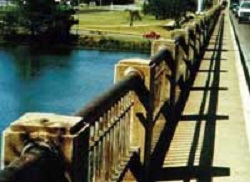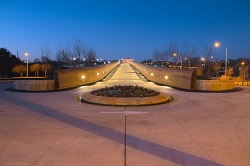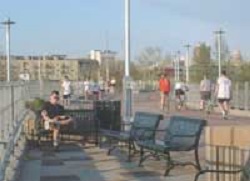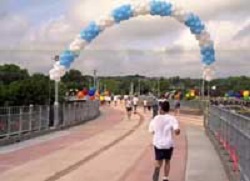Case Study No. 42
Pfluger Pedestrian-Bicycle Bridge
Austin, Texas
Prepared by Robert J. Schneider, Sprinkle Consulting, Inc. (SCI). Information provided by Kalpana Sutaria, City of Austin. 2012 updates provided by Nadia Barrera, Bicycle/Pedestrian Project Coordinator, City of Austin.
Problem
An existing historic bridge had high traffic congestion and sidewalks too narrow to accommodate pedestrians safely. A pedestrian and bicycle access across the river was needed without affecting the historic character of the bridge.
Background

The sidewalk on the congested Lamar Bridge was only 3.5 ft wide. Photo provided by the City of Austin.
One of the major bridge crossings in downtown Austin is the Lamar Bridge. This four-lane, art deco bridge constructed in 1941-1942 crosses a 700 ft section of the Colorado River. Until 2001, the bridge provided an important link in the City's main hiking and cycling trail system, but it was not an ideal crossing. The bridge had high levels of automobile congestion, and both of its sidewalks were only 3.5 ft wide. The nearest river crossing for pedestrians and bicyclists was over 1 mi away in either direction. Pedestrians who used the bridge were forced to walk single-file, and bicyclists often dismounted for the crossing. Because pedestrians were so close to the heavy traffic, there were many near misses and occasionally automobiles scraped people's arms. Tragically, a bicyclist was killed in 1991 when struck from behind by a drunk driver and a pedestrian was killed in 2000 when a vehicle jumped the 1 ft curb.

The bridge extension as completed in 2011.
The local community initially wanted to expand the bridge and provide cantilevered pathways for pedestrians and bicyclists at the sides of the bridge. However, the bridge had been designated as a historic site by the Texas Historical Commission in 1994; therefore, the existing bridge structure could not be modified.
Solution
In 1998, the City of Austin held public and design workshops to generate ideas for a new pedestrian and bicycle bridge to be constructed about 200 ft east of the Lamar Bridge. After the workshops were held, four design options were presented to the City Council, and the final design was chosen. Construction began in May 2000 and the Pfluger Pedestrian/Bicycle Bridge was completed in June 2001.

Pedestrians and bicyclists use Pfluger Pedestrian/Bicycle Bridge for commuting and recreation and also enjoy it as a destination. Photo provided by the City of Austin.
The bridge is accessible to all pedestrians, and is wide enough to serve a large number of pedestrian and bicycle commuters as well as recreational trips. Observation decks and benches were included in the design so that the bridge itself is an enjoyable destination for pedestrians and bicyclists.
Results
Pfluger Pedestrian/Bicycle Bridge has been extremely successful. The bridge design and construction won awards from the American Council of Engineering Companies, the Texas Council of Engineering Companies, and the Austin Chapter of American General Contractors. The total construction cost of the bridge was about $7 million, with $1 million provided by the Federal Intermodal Surface Transportation Efficiency Act (ISTEA) funds and $6 million paid by the City of Austin's Capital Improvement Program.

The Pfluger Pedestrian/Bicycle Bridge allows pedestrians and bicyclists to avoid crossing Lamar Bridge. After opening, it was used by 4000 to 5000 people per day, numbers which continue to rise.
Some people have complained that the bridge came at an extremely high cost, providing accommodations for pedestrians and bicyclists while doing little to relieve automobile congestion on Lamar Bridge. Yet, most of the public reaction to the bridge has been very positive. The City has received many calls and emails from citizens saying how much they enjoy the bridge. People who had stopped using the river crossing portion of the City's hiking and cycling trail system because it was so dangerous are now using it again.
One of the most notable impacts of the bridge has been the increase in the number of pedestrians and bicyclists who cross the river. Approximately 700 to 1,000 pedestrians and bicyclists crossed the Lamar Street Bridge each day before the Pfluger Pedestrian/Bicycle Bridge was built. Counts taken after the pedestrian/bicycle bridge was opened found that it was used by 4,000 to 5,000 pedestrians and bicyclists each day, and this number continues to rise. The dramatic increase in river crossings is the most obvious benefit of a bridge constructed to be both safe and enjoyable for bicyclists and pedestrians.
In 2011, the City of Austin completed the extension of the bridge as envisioned during the project area community planning process. This portion of the project extended the existing bridge over Cesar Chavez, a high traffic volume arterial roadway. The extension improved bicycle and pedestrian connectivity. The ribbon cutting was held on Feb. 5, 2011. Other pedestrian and bicycle connectivity projects have also be implemented in the area, creating a truly improved pedestrian and bicycle environment. In addition, many other related capital improvements are planned to be complete within the next several years to implement the City's vision to be healthy and connected. See the Seaholm District webpage for more information: http://www.austintexas.gov/department/seaholm-district.
Contact
Kalpana Sutaria, Architect and Project Manager
Public Works Department
505 Barton Springs Rd., Suite 900
Austin, TX 78704
Phone: (512) 974-7225
Email: kalpana.sutaria@austintexas.gov
Demira Wyatt
Public Works Department
505 Barton Springs Rd., Suite 900
Austin, TX 78704
Phone: (512) 974-7213
Email: demira.wyatt@austintexas.gov
Annick Beaudet
Project Sponsor, Public Works Department
505 Barton Springs Rd., Suite 750
Austin, TX 78704
Phone: (512) 974-6505
Email: annick.beaudet@austintexas.gov
Greg Kiloh
Project Sponsor, Economic Growth and Redevelopment Services
301 W. 2nd Street
Austin, TX 78701
Phone: (512) 974-7836
Email: greg.kiloh@austintexas.gov





